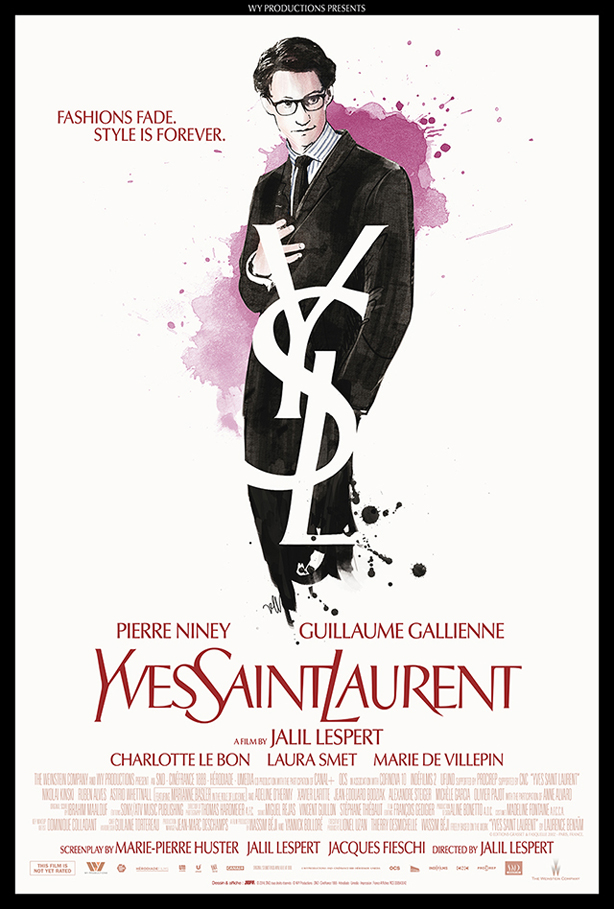Yves Saint Laurent
 Yves Saint Laurent Directed by: Jalil Lespert Cast: Pierre Niney, Guillaume Gallienne, Charlotte Le Bon Running Time: 1 hr 46 mins Rating: R Release Date: August 29, 2014
Yves Saint Laurent Directed by: Jalil Lespert Cast: Pierre Niney, Guillaume Gallienne, Charlotte Le Bon Running Time: 1 hr 46 mins Rating: R Release Date: August 29, 2014
PLOT: The life story of Yves Saint Laurent (Niney), the business he started, and the relationship he had with Pierre Berge (Gallienne).
WHO'S IT FOR? Those who watch period movies for the fashion.
OVERALL
Yet another confirmation of the biopic’s turgid storytelling DNA is found with Yves Saint Laurent, an empty re-telling of the haute couture mega icon’s life. It includes the usual list of foibles that human beings are defined by when treated as characters in a non-fictional movie, which of course means love, drugs, and haircut fads. Only personal details about the love life of Saint Laurent contend to be revelations within this biopic. There is little intrigue about the art created by the icon, even though that’s … um … why a film was made about him in the first place.
Using Saint Laurent’s company’s icon for its opening title sequence, the movie is most of all a period-era commercial of retro designs. Pierre Niney plays the juggernaut without complication, but a mass amount of conflict. One can see the pain within his presentation of the socially reclusive Saint Laurent, but there's not the seed planted by the actor to investigate his psyche, as there doesn’t seem to be much else there.
Aside an arc that shows Saint Laurent starting his own company after getting nicked from Dior, the movie follows a lifelong story of the icon’s relationship with business partner/life partner Pierre Berge (Guillaume Gallienne). They have a love that wavers back and forth, with their relationship sometimes affecting how they conduct their business. With Saint Laurent becoming more restless as his hard work finds a wider audience, their relationship becomes most interesting in regards to how Berge tries to control Saint Laurent, and to what ends. Niney and Gallienne have some visceral chemistry, but their work is pointed by Jalil Lespert's film towards melodrama.
Yves Saint Laurent divides itself into two separate parts. The love between Berge and Saint Laurent is its first and its priority, the actual icon’s expression in an art form that he helped define is a secondary interest. An example can be found in the moment when Saint Laurent apparently starts a fashion craze by using the art of Dutch painter Piet Mondrian. Yves Saint Laurent reduces this revelation to a flat scene in which the icon is seen toiling over drawings, and then goes over to his library and opens a book. With artistic license involved in the biopic, was there not a more interesting way to express this moment, to show the spark that is within his art?
Lespert’s film does have some shiny moments during its runway sequences, which satisfy interest in witnessing previous era fashion as recreated through painstaking period detail. These simple pieces of pleasure come with a frustratingly small sense of narrative progression, and are indicative of how this movie concerned with fashion fails to convey the art-form’s most interesting quality. Including its commercial elements, the hyperbolic outfits and clothes displays are not meant to be taken entirely literally, but as an expression of an ever-evolving culture of unique expression. The presentation of an artistic life in a movie (like this one) should be similarly bolstered by detaching from the literal details, and in expressing them instead as the walking art forms they have become. (With this being said, Yves Saint Laurent is no Frank.)
Handling this idea of artistry within biopic standards, Yves Saint Laurent treats the character’s essential elements as only plot points, focusing on a personal life that doesn’t have the narrative fortitude to justify the limelight put upon it. Yves Saint Laurent is a fashion film that loses its footing when it steps off the runway.
FINAL SCORE: 4/10